|
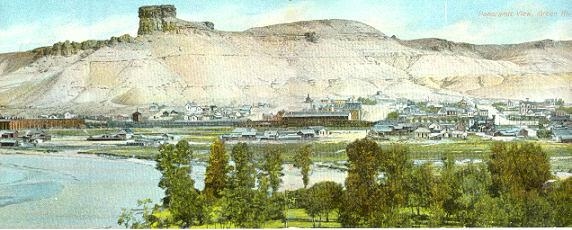
Green River, approx. 1910
The first Green River was a stage station located about
34 miles north of the present city. The second was on the south side of
the river.
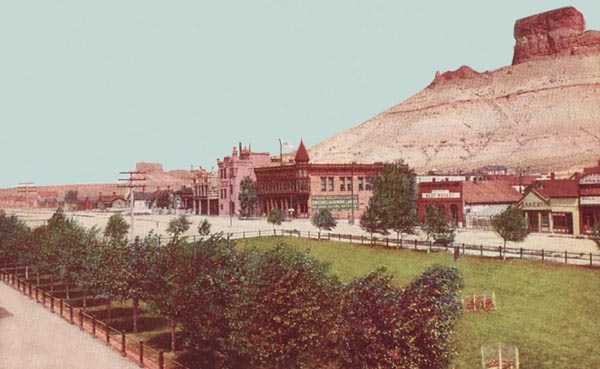
Green River, approx. 1907, see close-up next photo.
Earlier photographs and postcards of the various towns in southern Wyoming reflect a dirth of trees or grass. The park with
the greensward in the above postcard owes its existence to an offhand comment by E. H. Harriman, president of the Union Pacific Railroad from
1904-1907. Edward Henry Harriman (1848-1909) controlled in addition to the Union Pacific, The Southern Pacific, The Saint Joseph and
Grand Island, the Illinois Central, Central of Georgia, the Wells Fargo Express Company and the
Pacific Mail Steamship Company. Thus, his wishes were to be obeyed and should like expressions from the Diety not to
be questioned. On an inspection tour of the Railroad about 1904, Mr. Harriman paused in
Rock Springs and commented to the then Division Superintendent W.H. Park as to the railway depot sitting in all of its glory in the
middle of the barren right-of-way where not a weed grew,
"The station is of attractive design, and some grass and a little shrubbery would freshen things up
wonderfully." A local resident responded, "Mr. Harriman, there is not a sprig of grass in Rock Springs; not because we
don't want it, but because the percentage of alkali in the soil is an absolute bar to its growth." Harriman replied,
"Nothing is impossible."
Hundreds of cars rolled, bringing forth fertile soil from Utah. Parks were constructed all up and down the line. In the words of
Division Superintendent Park:
The result was the beautiful
park at Cheyenne, and the improvement of the
landscape at all terminals, which, in a few years, transformed
the Union Pacific from a road through a desert
to one along which the bright green grass, trees, and
flowers were in evidence at every station of importance.
Park, W. H., Recollections of E. H. Harriman in Connection with the Union
Pacific, unpublished manuscript quoted by George Kennan, E. H. Harriman: A Biography,
Houghton Mifflin Company, Boston, 1922.
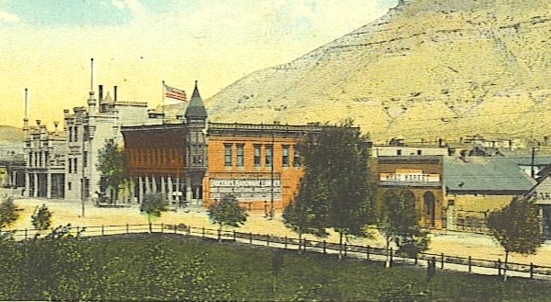
Green River, approx. 1907.
The building with the Moorish revival tower is the Morris Mercantile and Bank (See closeup lower on
page). To its
left is the Sweetwater Brewery. The brewery was constructed in 1900 by Hugo Gaensslen and modeled after
the Chicago water tower in his native Chicago. Gaensslen purchased the brewery in 1891 when it was
located in a wooden one-story building on what is now Railroad Avenue. The brewery was founded as
the Green River Brewery in 1872 by Adam Braun. It name was changed to Sweetwater
Brewing Company in 1899. In 1904 and 1905, the beer won medals at two World's Fairs.
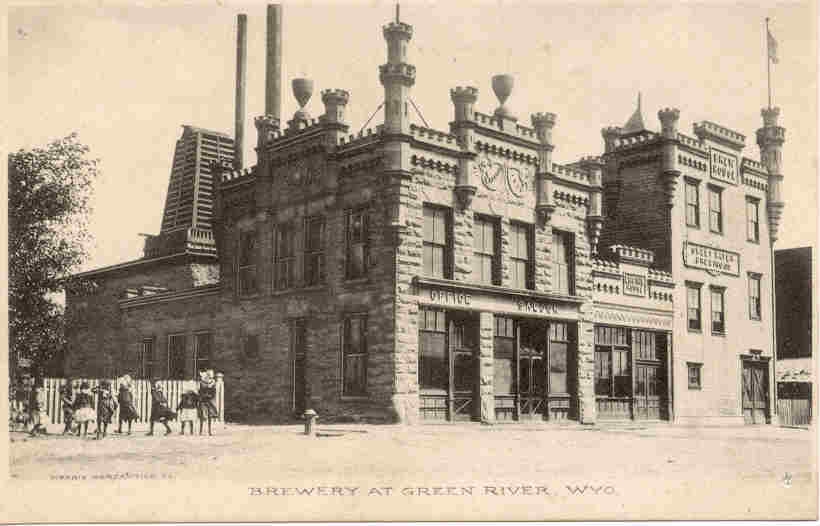
Sweetwater Brewery, Green River, undated
The three-story portion of the brewery was razed in the 1970's. As indicated in the
next photo, the two-story portion housing the
office is now (2003) a deli and bar.
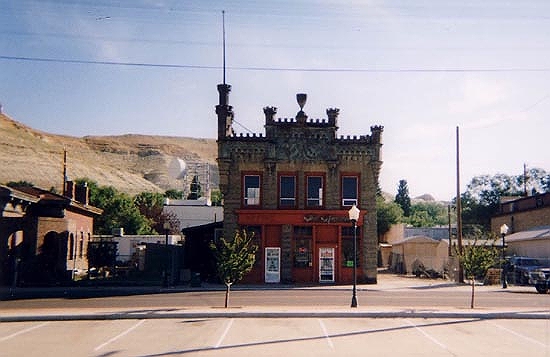
Remnants of Sweetwater Brewery Building, 2003. Photo by Mark Morgan.
For the first several years Green River City housed the temporary jail for Carter County (renamed Sweetwater
County in 1869),
although the county seat was in South Pass City 75 miles miles to the northeast. By 1870 South Pass City
had obtained its own jail but it was obvious that South Pass City was fading. By 1872 Green River City was showing growth with,
among other things, the Sweetwater Brewery. The following year,
1873 the county seat was moved from South Pass City. The City was
incorporated in 1891. Because of county line changes, South Pass City is now in Fremont County.
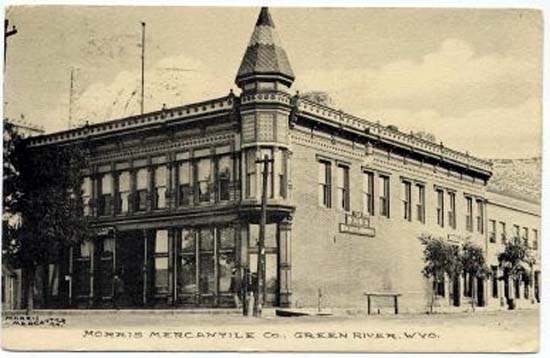
Morris Mercantile Co., approx. 1909
The building burned about 1920. Some of its bricks were used in the construction
of the Immaculate Conception parish house. Many of the photos on this web site were originally published
by local mercantile companies such as Morris. An example of one published by Morris
Mercantile is the photo of the Western Alkali Co., from about 1910, below right.
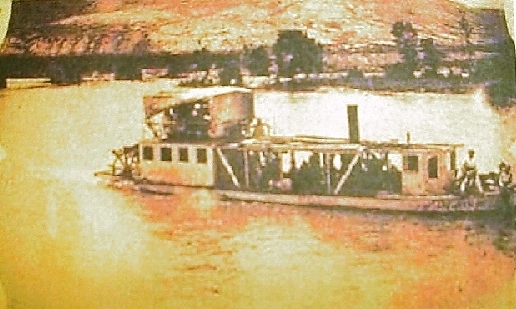
The Steamboat "Comet," 1908
Except for steamboats on Lake Yellowstone, steam navigation is not something for which
Wyoming is noted. In March, 1908, a group of Wyoming and Utah businessmen formed the Green
River Navigation Company for the purpose of carrying of passengers and
freight by steam, gasoline, and other powered boats. Holger Larsen, a German
boatbuilder and brother of one of the shareholders, came to Wyoming and after examination of the river, determined that steam navigation
was practicable on the Green River between Green River City and Linwood, Utah.
Impetus for the project was the isolation of Brown's Hole where Linwood was located. The area was cut off
from Colorado and Utah. Access was provided from Wyoming only by the Ft. Thornburgh road established by
Judge Carter. The road was generally abandoned after the fort was decommissioned. Indeed,
there was no access to Daggett County, where Linwood was located, by paved road until 1954.
A boatyard was
constructed in Green River City, and the necessary boiler and two 20-horsepower steam engines were shipped in from
Chicago. On the Fourth of July, amid appropriate celebration, the vessel was
christened with the maiden voyage to Linwood scheduled for July 7.
Fares were set at $5.00 for the roundtrip excursion. Ticket offices were established
at Marius Larsen's office at the Linwood Mercantile Company and at Hugo Gaensslen's office at the Sweetwater
Brewery in Green River City.
On the appointed day, the vessel departed for Linwood with
Holger Larsen as pilot; Marius Larsen as purser; Otto Kaehler, chief engineer;
J. H. Crossen, fireman; George Solomon, anchor man; and J. W. Chrisman is charge of the
ample supplies of beer. Solomon was Linwood's founder and with Marius Larsen, a founder of the
People's Canal Company intended to provide irrigation to the area.
Notwithstanding the vessel getting snagged on occasional sandbars, the
55 mile voyage to Linwood was accomplished in only eight hours.
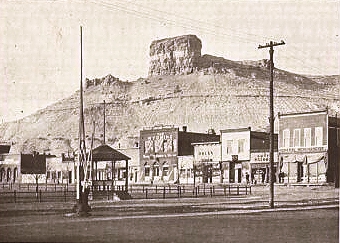
Green River City, 1907, photo by Barber and Jukes, Rawlins
The return trip upstream proved not to be quite so uneventful, taking over thirty-three hours. The
sixty-foot, 40-ton vessel repeatedly had to be manually wenched off sandbars with lines staked to the
shore. The coal bunkers proved
to be inadequate and the ship ran out of fuel. Thus, the passengers had to wait while
additional coal was obtained from neighboring ranches. A second voyage was undertaken to
take frieght from the railhead at Green River City to Linwood. Again, the
vessel proved to have too great a draft to pass over the sandbars. The passengers and
crew had to repeatedly unload the freight to get the Comet over the shoals. After the return to
Green River City, the vessel was used for an occasional short excursion until it was stripped of her engines and
boiler, and the hull sunk about 300 yards below the present day Highway 530 Bridge. The bell
was used by the Rotary Club. Linwood, today, is properly referred to in the past tense.
It was located on the Wyoming-Utah border, east of Manila. By 1950, the population had dwindled to
18 and in the 1960's the town disappeared beneath the waves of the Flaming Gorge Reservoir.
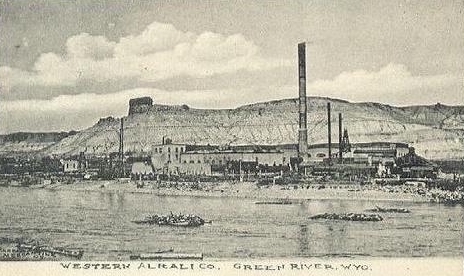
Western Alkali Co., approx. 1910
The size of the coal bunkers reminds the writer of an episode some years ago with a friend who
decided that he would go into the "long lines" mackerel fishing business on the
Atlantic Coast. This required that a suitable fishing trawler be designed and built. Since it was intended
that the vessel would be out to sea for thirty days at a time, it was necessary that the
fish hold be capable of containing a suitable tonnage of fish. Unfortunately,
when the ship put out to sea, it became obvious that the fish hold was too small. Investigation
revealed that the marine architect in determining the dimensions of the hold, had gone to
a local grocery store, purchased several packages of Mrs. Paul's fish, measured the size of the
package and multipled it by the weight to make the calculations for the size of the hold, forgetting that fish in
the ocean are not square.
Next page Rock Springs.
|